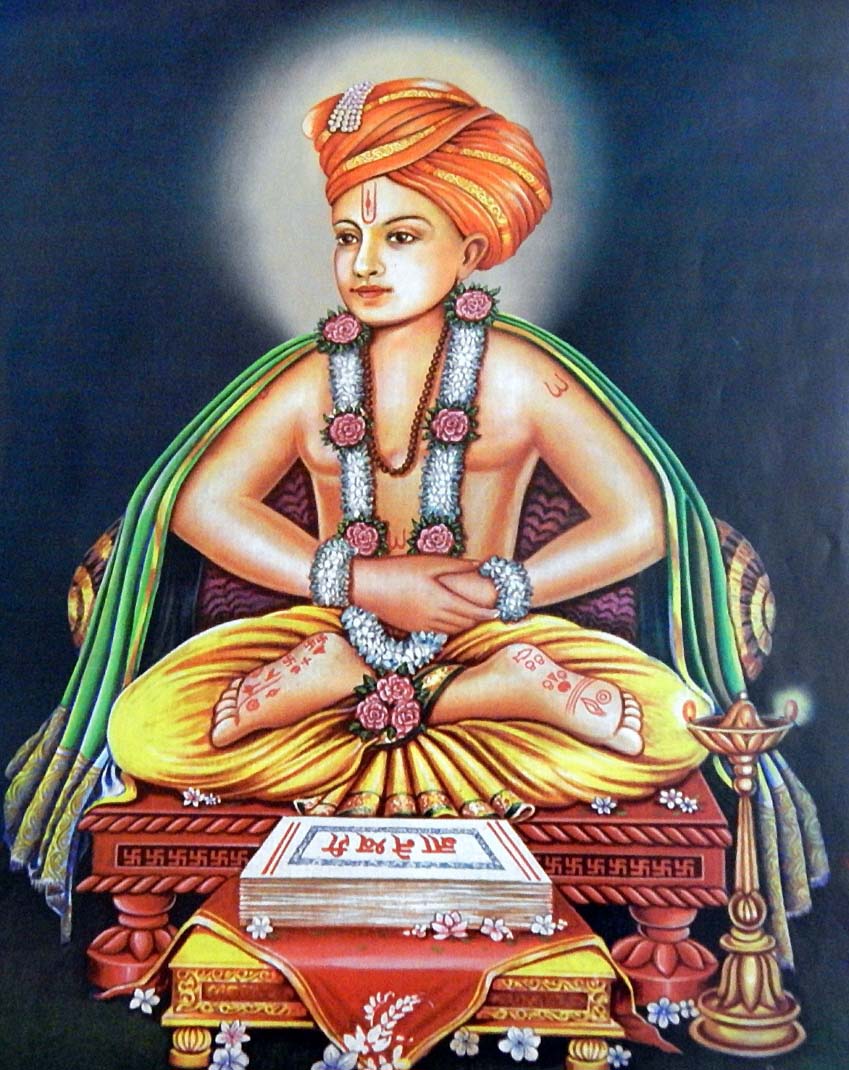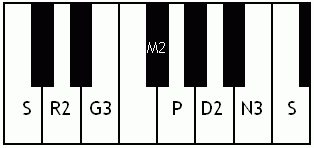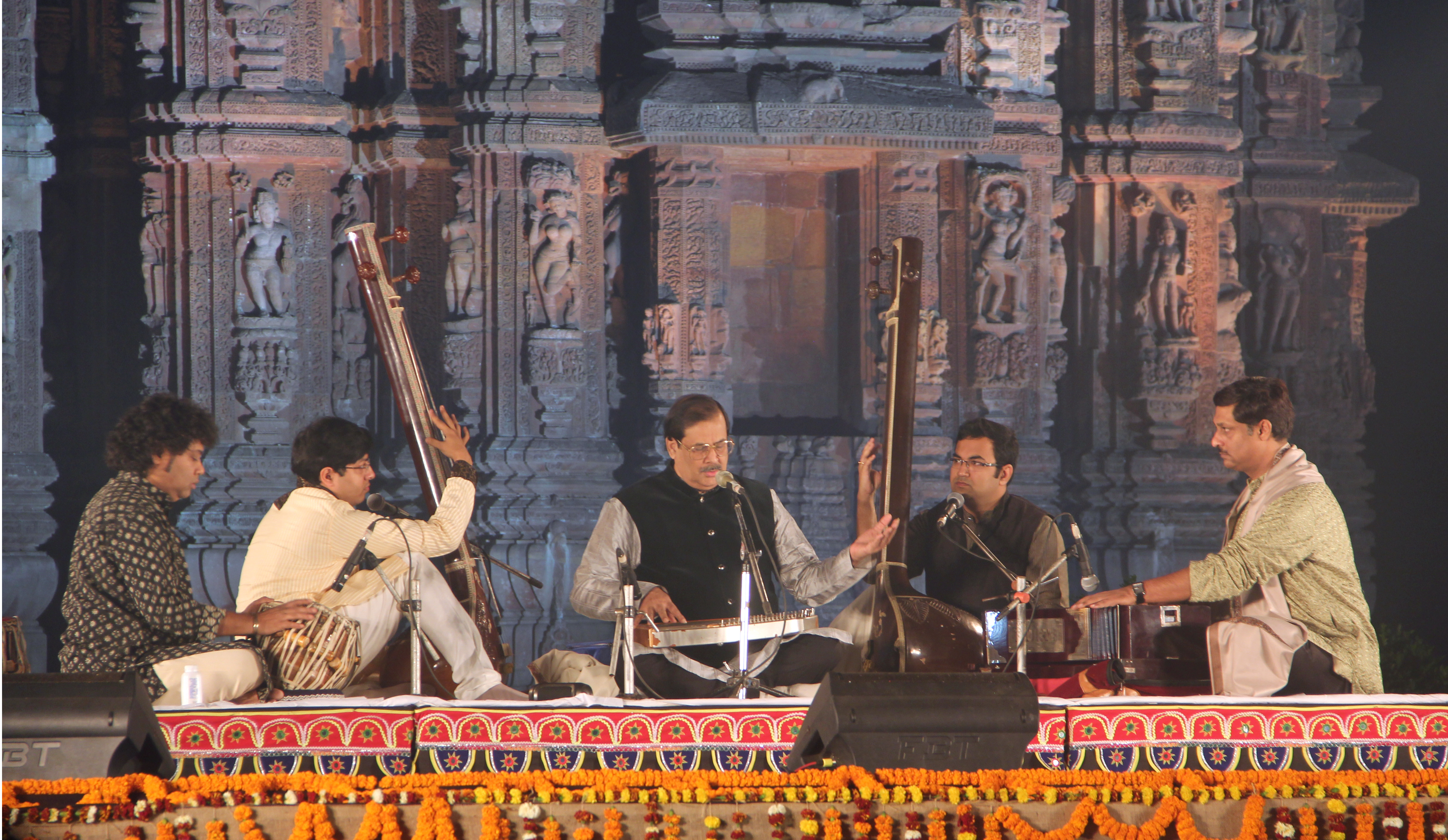|
Krishnarao Phulambrikar
Krishnarao Ganesh Phulambrikar (1898–1974), popularly known as Master Krishnarao, was an Indian vocalist, classical musician and composer of Hindustani music. He was credited with the creation of three Hindustani ragas and several bandishes. Phulambrikar, a recipient of the Sangeet Natak Akademi Fellowship, was also the music composer of several movies, including Dharmatma, a 1935 Hindi film starring Bal Gandharva, a renowned Marathi singer and Padosi, a 1941 directorial venture of V. Shantaram. The Government of India awarded him the third highest civilian honour of the Padma Bhushan, in 1971, for his contributions to music. Biography Krishnarao Phulambrikar was born in 1898 at Devachi Alandi, a town in the periphery of Pune, in the western Indian state of Maharashtra to the Deshastha Brahmin couple Ganesh Phulambrikar and Mathura bai. He also ventured into Marathi theatre as a child artist by performing as an actor-singer in ''Sant Sakhu'', a musical drama produced by '' ... [...More Info...] [...Related Items...] OR: [Wikipedia] [Google] [Baidu] |
Alandi
Alandi (Marathi pronunciation: ːɭən̪d̪iː is a town and a municipal council in the Pune district in the state of Maharashtra, India. The town is popular as a place of pilgrimage and the resting place of the 8th century Marathi saint Sant Dnyaneshwar. History Alandi has a long history but gained prominence in the 13th century when Dnyaneshwar (1275–1296) decided to entomb, otherwise known as '' sanjeevan samadhi'', himself in a samadhi, a form of shrine, under the then existing Siddheshwar temple complex in 1296. A temple was built over the Samadhi by Ambekar Deshpande in around 1580–1600. Further additions to the temple were made during the Maratha Empire era by Maratha nobles and the Peshwa. In 1778, Alandi was granted to Mahadji Shinde, the powerful Maratha statesman of the Maratha confederacy at that time, by the Peshwa. For two decades after that, the Shinde family were the main sponsors of various renovations of the temple. In the 1820s, Haibatraobuva Arph ... [...More Info...] [...Related Items...] OR: [Wikipedia] [Google] [Baidu] |
Gwalior Gharana
The Gwalior Gharana (Gwalior school of classical music) is one of the oldest Khyal Gharana in Indian classical music. The rise of the Gwalior Gharana started with the reign of the Mughal emperor Akbar (1542–1605). The favourite singers of this patron of the arts, such as Miyan Tansen, who was the most famous vocalist at the court, came from the town of Gwalior. History The Gwalior Gharana evolved during the time of the Mughal Empire (1526CE 1857 CE). Among the early masters (''ustad'') were Naththan Khan, Naththan Pir Bakhsh and his grandsons Haddu, Hassu and Natthu Khan. The head musician in the imperial court was Bade Mohammad Khan, who was famous for his ''taan bazi'' style. Both Bade Mohammad Khan and Naththan Pir Bakhsh belonged to the same tradition of Shahi Sadarang (also known as Nemat Khan, dhrupad singer and veena player in the court of Mohammad Shah (1702 CE 1748 CE). Hassu Khan (died 1859 CE) and Haddu Khan (died 1875 CE) continued to develop the Gwalior sty ... [...More Info...] [...Related Items...] OR: [Wikipedia] [Google] [Baidu] |
Jaunpuri (raga)
Raga Jaunpuri is a rāga in Hindustani classical music in the Asavari thaat. Some musicians like Omkarnath Thakur consider it indistinguishable from the shuddha rishabh Asavari Raga Asavari () is a Hindustani classical raga. It belongs to the Asavari thaat and is performed in the morning hours. In pre- Bhatkhande days this Asavari used the Komal Rishab instead of Shuddh Rishab. When Bhatkhandeji created the thaat pr ....Rajan ParrikarAsavari and Associates Its attractive swaras also make it a popular raga in the Carnatic circles with a number of compositions in South India being tuned to Jaunpuri. The name of the rāga may associate it with places of this name, such as Javanpur in Gujarat, close to Saurashtra (region), Saurasthra region and Jaunpur, Uttar Pradesh, Jaunpur in northern Uttar Pradesh. History Jaunpuri was created by Sultan Hussain Sharqi of Jaunpur. Structure The Pakad is "m P n d P, m P g, R m P" It is usually performed in morning (9-12pm). In Car ... [...More Info...] [...Related Items...] OR: [Wikipedia] [Google] [Baidu] |
Bibhas
Bibhas is a Hindustani classical raga. Theory Bibhas (sometimes also called 'Vibhas') is a pentatonic raga belonging to the Bhairav Thaat. This Raga is sung during daybreak. It is quite similar to Raga Deshkar as changing the Shuddha Dha and Shuddha Re of Deshkar converts it into Bibhas. The true nature of Bibhas has and flat. However, it is very rarely performed using the Shuddha Dha. In order to maintain the pure character of Bibhas, it is very important that Pa is not the last note during any alap or taan. The atmosphere created by this raga is serious, as it has Komal '' and ''. Arohana and avarohana Arohana: S r G P d S' Avarohana: S' d P G r S Thaat Bhairav Thaat Vadi and samavadi & Pakad or Chalan r* G r* G, P d* S', d* P G r* S. Organization and relationships Related ragas: Deshkar Behavior Behavior refers to practical aspects of the music. It is complicated to talk about this for Hindustani music since many of the concepts are fluid, changing, ... [...More Info...] [...Related Items...] OR: [Wikipedia] [Google] [Baidu] |
Bilaval
Bilaval or Bilawal () is a raga and the basis for the eponymous ''thaat'' (musical mode) in Hindustani classical music. Raga Bilaval is named after Veraval, Gujarat. Bilaval has been the standard for North Indian music since the early 19th century. Its tonal relationships are comparable to the Western music C major scale. Bilaval appears in the '' Ragamala'' as a ragini of Bhairav but today it is the head of the Bilaval thaat. The Ragamala names Bilaval as a Putra (son) of Bhairav but no relationship between these two ragas are made today. Bilaval is a morning raga that is intended to be sung with a feeling of deep devotion and repose and is often performed during the hot months. The Bilaval is equivalent to the Carnatic raga melakarta, Sankarabharanam, as well as the Western Ionian mode (major scale), and contains the notes S R G M P D N S'. The pitches of Bilaval thaat are all ' (natural). Flat () or sharp () pitches always occur regarding the interval pattern in Bilaval ... [...More Info...] [...Related Items...] OR: [Wikipedia] [Google] [Baidu] |
Shivaranjani
Shivaranjani or Sivaranjani is a musical scale used in Indian classical music. There are two scales, one in Hindustani music and one in Carnatic music. The Hindustani rāga is a pentatonic scale, as is the Carnatic scale categorized as Audava-Audava (''audava'' meaning 'of 5') resulting in 5 notes in the Arohanam and 5 in the Avarohanam. Hindustani scale The Hindustani rāga ''Shivaranjani'' belongs to the '' Kaafi thaat'' in terms of classification of the scale.''Raganidhi'' by P. Subba Rao, Pub. 1964, The Music Academy of Madras Its structure is as follows: * : * : The ''komal''(soft) ''gandhar''(g) in place of ''shuddh gandhar'' (G) is the difference between this rāga and the global musical scale of '' Bhoop''. Borrowed into Carnatic music In Karnatic Music, this is a ''janya'' rāga (derived scale) from 22nd mela-kartha raga Kharaharapriya. It is a ''audava-audava'' rāgam in Carnatic music classification (i.e., a ragam that has five notes in both its arohan ... [...More Info...] [...Related Items...] OR: [Wikipedia] [Google] [Baidu] |
Kalyani (raga)
Kalyani is a melakarta raga (parent musical scale) in the Carnatic music. It was called Kalyan but is now more popularly called Yaman in Hindustani Music. Its Western equivalent is the Lydian mode. Kalyani in Carnatic music In South Indian weddings it is a very prominently played raga. The word ''Kalyani'' means ''she who causes auspicious things''. It is the 65th melakarta raga under the Katapayadi sankhya. It is also called ''Mechakalyani''. The notes for Kalyani are S R2 G3 M2 P D2 N3. Kalyani is the first Prathi Madhyama raga that was ever discovered. It was obtained by the process of Graha Bhedam or modal shift of tonic of the ancient Shadja Grama. Specifics on this raga Kalyani has scope for elaborate alapana. One should not remain too long on panchamam (pa) or alternate between shadjamam and panchamam too frequently. Kalyani is prominently known among the public. It is often performed at the beginning of concerts because it is considered auspicious. Structure and ... [...More Info...] [...Related Items...] OR: [Wikipedia] [Google] [Baidu] |
Todi (raga)
Miyan ki Todi, often simply referred to as Todi or Darbari Todi (), is a Hindustani classical raga which gave its name to the Todi thaat, one of the ten types of classical music according to the musicologist Bhatkhande. Ragas from the Todi raganga (class of ragas) include Todi (a.k.a. Miyan ki Todi) itself, Bilaskhani Todi, Gujari Todi (also called Gurjari Todi), Desi Todi, Hussaini Todi, Asavari Todi (more commonly known as Komal Rishabh Asavari), and Bahaduri Todi. The equivalent raga in Carnatic music is Shubhapantuvarali. But in Todi, the pancham is omitted in the Arohana, whereas Shubhapanthuvarali uses the panchamam in both the arohana and avarohana. The Carnatic Melakarta Hanumatodi is the equivalent of Bhairavi thaat, but the Hindustani Bhairavi raga is the equivalent of Carnatic Sindhu Bhairavi. Carnatic Todi does not have any similarity with Hindustani Todi (Miyan ki Todi) raga. Though the Swarasthana orders of Carnatic Thodi are similar to Hindustani Bhair ... [...More Info...] [...Related Items...] OR: [Wikipedia] [Google] [Baidu] |
Thumri
Thumri () is a vocal genre or style of Indian music. The term "thumri" is derived from the Hindi verb ''thumuknaa'', which means "to walk with a dancing gait in such a way that the ankle-bells tinkle." The form is, thus, connected with dance, dramatic gestures, mild eroticism, evocative love poetry and folk songs, especially from Uttar Pradesh, though there are regional variations. The text is romantic or devotional in nature, the lyrics are usually in Uttar Pradesh dialects of Hindi called Awadhi and Brij Bhasha. Thumree is characterized by its sensuality, and by a greater flexibility with the ''raga''. ''Thumri'' is also used as a generic name for some other, even lighter, forms such as Dadra, Hori, Kajari, Sawani, Jhoola, and Chaiti, even though each of them have their own structure and content — either lyrical or musical or both—and so the exposition of these forms vary. Like Indian classical music itself, some of these forms have their origin in folk literature and ... [...More Info...] [...Related Items...] OR: [Wikipedia] [Google] [Baidu] |
Khayal
Khyal or Khayal (ख़याल / خیال) is a major form of Hindustani classical music in the Indian subcontinent. Its name comes from a Persian/Arabic word meaning "imagination". Khyal is associated with romantic poetry, and allows the performer greater freedom of expression than dhrupad. In khyal, ragas are extensively ornamented, and the style calls for more technical virtuosity than intellectual rigour. Etymology (خیال) is an Urdu word of Arabic origin which means "imagination, thought, ideation, meditation, reflection". Hence khyal connotes the idea of a song that is imaginative and creative in either its nature or execution. The word entered India through the medium of the Persian language. Just as the word reflects ideas of imagination and imaginative composition, the musical form is imaginative in conception, artistic and decorative in execution and romantic in appeal.Francis Joseph Steingassخیال A Comprehensive Persian-English Dictionary Characteristics ... [...More Info...] [...Related Items...] OR: [Wikipedia] [Google] [Baidu] |
Ram Marathe
Ramchandra Purushottam Marathe (23 October 1924 – 4 October 1989), also known as Pandit Ram Marathe, was a Marathi music director, singer, and actor on stage and in films. As a child actor, he performed the title role of Krishna in Prabhat Film Company's 1938 film, Gopal Krishna. He was disciple of Vilayat Hussain Khan, the maestro of Agra gharana of Hindustani classical music., Master Krishnarao Phulambrikar Krishnarao Ganesh Phulambrikar (1898–1974), popularly known as Master Krishnarao, was an Indian vocalist, classical musician and composer of Hindustani music. He was credited with the creation of three Hindustani ragas and several bandishes. Ph ... and others. Through Master krishnarao, he developed his Khayal style which had elements of different gharanas such as Jaipur, Gwalior and Agra. Shah, V. and Kashalkar, U., 2011. A Conversation with Ulhas Kashalkar. India International Centre Quarterly, 38(1), pp.134-14/ref> Early life and education Pandit Ram Marathe was ... [...More Info...] [...Related Items...] OR: [Wikipedia] [Google] [Baidu] |
Jyotsna Bhole
Jyotsna Keshav Bhole also known as Jyotsnabai Bhole ( mr, ज्योत्स्ना केशव भोळे) (11 May 1914 – 5 August 2001), was a veteran Marathi stage artist and a Hindustani classical singer. Along with Padmabai Vartak, she was among the first female actresses to perform the role of a female character in Marathi theatre in the play ''Andhalyachi Shala'' in 1933. Bhole was popularly known for the drama song ''Bola Amrut Bola'' composed by Sangeetkalanidhi Master Krishnarao Phulambrikar. She was awarded Sangeet Natak Akademi Award in 1976, given by the Sangeet Natak Akademi, India's National Academy of Music, Dance & Drama. Early life and education Jyotsna was born on 11 May 1914 as Durga Kelekar in a small village in Goa. She was one of the fourteen siblings born to Radhabai and Vaman Kelekar. From a young age, she had an inclination towards music. After completing second grade in a local school, she moved to Mumbai at the age of eight with h ... [...More Info...] [...Related Items...] OR: [Wikipedia] [Google] [Baidu] |




